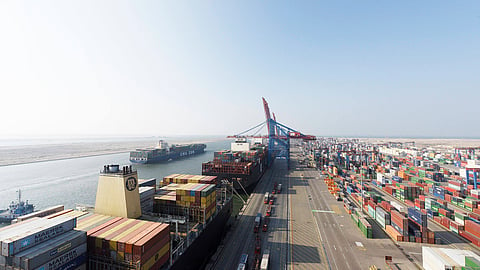Suez Canal Container Terminal Gets Better Connectivity
APM Terminals is working closely with the government of Egypt to provide better infrastructure and connectivity to its Suez Canal Container Terminal (SCCT).
These initiatives will provide the final pieces of the jigsaw that will ensure the success of Egypt Vision 2030 for Port Said East Port and SCCT.
Once in place, it is set to regain its position as one of the most competitive ports in the South and East Mediterranean region.
As part of Egypt Vision 2030, the Egyptian Government has made massive investments in infrastructure.
On May 5, 2019, Egypt’s President, Mr. Abdel Fattah Al-Sisi inaugurated the Ismailia tunnel, which will ease the flow of traffic and cargo from and to the Sinai Peninsula.
The tunnel significantly improves connectivity between SCCT and key industrial zones in Greater Cairo. A second tunnel connecting Port Said is scheduled to open this summer.
The Ismailia tunnel, which runs under the Suez Canal, is the largest of its kind and has the capacity to handle 2,000 vehicles per hour in each direction.
The entrances to the tunnel, in both directions, are equipped with 10 scanners to scan vehicles and trailers entering the tunnel. They have the capacity of scanning up to 250 vehicles per hour. Six of these 10 lanes will be completely dedicated to trucks and trailers.
A new six-lane highway also links SCCT’s location on the Sinai Peninsula with key metropolitan areas in the western part of the country.
The tunnel is expected to quickly ramp up to full operational mode. This will significantly improve truck journey times between Greater Cairo and SCCT, which are currently between two and three days, and reduce cost for the end customer.
APM Terminals’ Garment-on-Hanger Service Benefits Retailers
Said SCCT’s CEO, Lars Vang Christensen: “It is the first time we have seen this quality of roads and tunnels in this part of the world. Together with improved security around the port it's truly an achievement of the highest international standard for Egypt.
“This new development will make SCCT the primary gateway for cargo in and out of Egypt.
“This is one of the final pieces of the jigsaw for ensuring we become the primary gateway to the region.
"We have an outstanding location, with no deviation for the main routes on trade lanes between Asia and Europe. Our employees are doing an outstanding job.
“We are regarded as the most efficient port in the region with extremely high productivity, and a safety record among the very best.”
Around 95% of SCCT’s traffic is currently made up of transhipment volumes.
Located at the northern entrance of the Suez Canal, SCCT is the best transhipment hub for ships moving from South East Asia to the Mediterranean and Europe, as well as serving feeder lines in the Mediterranean and the Egyptian market.
The terminal’s strategic location provides lower bunker costs for Shipping Lines calling SCCT, compared to others in the region.
Port tariffs were relaxed in November 2018, but Christensen is currently working closely with the Egyptian government to achieve further incentives that would restore the terminals competitiveness in the region and attract higher volumes.
The investment was part of the broader government Vision 2030, which focuses on creating jobs and a balanced market economy that is competitive on the world stage.
APM Terminals Increases Rail Connectivity
Said Christensen: "Egypt Vision 2030 is all about creating a logistics infrastructure for IT companies, car manufacturers, and other sectors producing goods in Egypt.
"Egypt’s competitive labour costs combined with Vision 2030 provides key opportunities for global companies."
Christensen is also keen to emphasise the significant role that SCCT can play in creating jobs and economic growth. When operating at full capacity the terminal contributes around 3,000 direct and indirect jobs to the economy.
Currently, the terminal has an annual capacity of 5.4 million TEUs. With the anticipated higher volumes, SCCT is planning to invest in taller cranes and equipment to service larger container ships.
In the future the terminal also has the potential to expand the length of its quay by an additional 450 metres.
Christensen believes that the combination of the Port’s facilities, location, the new tunnels and highway infrastructure, and a potential further reduction in port tariffs could result in, “Egypt becoming the new Malaysia or Singapore".
He is hopeful that the country’s Vision 2030 initiative will also deliver the essential business framework that will also be essential to achieve this and be truly competitive in the region.


